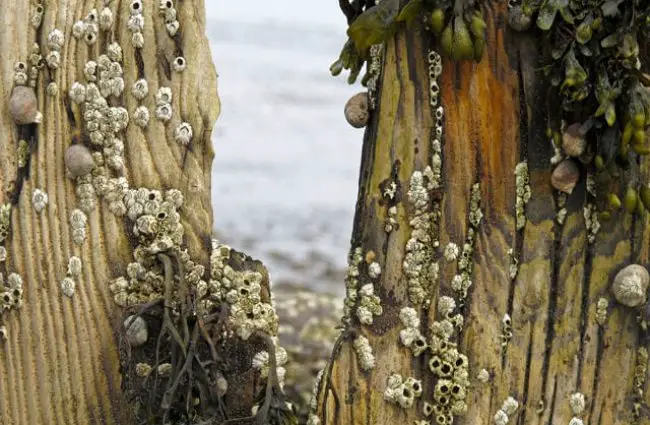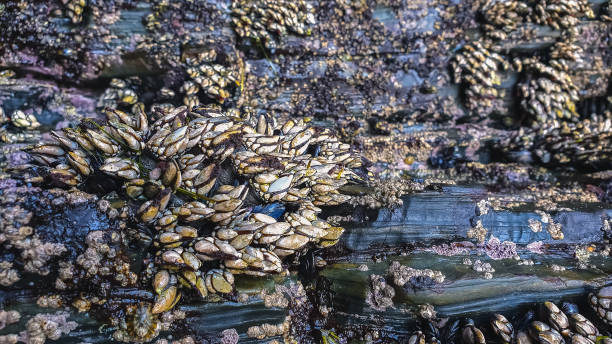The Barnacle Arthropod - Tiny Wonders Of The Ocean
When you think of ocean creatures, your mind might go straight to colorful fish, majestic whales, or perhaps even playful dolphins. But there's a whole world of smaller, equally fascinating beings that often get overlooked, clinging quietly to rocks and ships. Among these, the barnacle arthropod stands out as a truly unique marine animal, a little marvel that, in some respects, has found a remarkable way to live its life. You know, these creatures are more connected to some familiar ocean dwellers than you might initially guess.
These little animals are actually a type of arthropod, a big group of creatures known for their jointed limbs and hard outer coverings. So, when we talk about a barnacle arthropod, we are talking about a distant cousin to many insects and spiders you see on land, but also, very importantly, to the crabs and lobsters that scuttle across the ocean floor. They share a family tree, you could say, with these more well-known shellfish, even having a similar tiny larval stage when they are just starting out in the water. It’s pretty cool, if you think about it, how all these different creatures are linked.
Barnacles are exclusively marine, which means they only live in saltwater, and you’ll often find them in places where the water is not too deep, like along coastlines where the tides come and go. They have a rather interesting way of life, choosing to settle down permanently once they are ready to grow up. Their appearance, often a hard, protective outer shell, helps them survive in these sometimes rough environments. They are, in fact, quite tough little things, holding on tight to whatever surface they pick as their home. Seriously, they really do stick around.
Table of Contents
- What Are Barnacles?
- Barnacle Arthropod Family Ties
- Where Do Barnacle Arthropods Call Home?
- The Many Faces of the Barnacle Arthropod
- How Do Barnacle Arthropods Stick Around?
- Barnacle Arthropods and Their Whale Friends
- What Makes a Barnacle Arthropod Unique?
- A Closer Look at Specific Barnacle Arthropod Types
What Are Barnacles?
Well, to put it simply, a barnacle is a type of arthropod, a big group of animals that includes things like insects, spiders, and crustaceans. More specifically, they fit into a category called Cirripedia, which is a special group within the subphylum Crustacea. So, basically, they are marine invertebrates, meaning they live in the ocean and do not have a backbone. They are, you know, a bit like tiny, shelled squatters of the sea. Their overall structure, with that tough outside, helps them withstand the ocean's forces.
These creatures are known for their rather distinct lifestyle. Unlike their mobile relatives, barnacles choose a spot and then stay there for the rest of their lives. They are highly modified for this stationary existence, which is a pretty interesting adaptation, if you ask me. This means their bodies have changed quite a bit over time to help them live this particular way. They are, in fact, quite amazing examples of how life can adapt to specific conditions. You might, for example, see them just about everywhere along coastlines.
Barnacle Arthropod Family Ties
It might surprise some people, but the barnacle arthropod is actually quite closely related to some of the ocean's more famous residents. Think about crabs and lobsters; these are their close kin. They share a common ancestor and even go through a similar early life stage, known as a nauplius larva. This tiny, free-swimming form is a key sign of their shared lineage. So, in a way, when you see a barnacle, you're looking at a distant cousin of your favorite seafood. It's a pretty neat connection, honestly.
The entire group of arthropods is incredibly diverse, stretching from the smallest insects to the largest crustaceans. The barnacle arthropod belongs to this vast phylum, which also contains all of the world’s lobsters, shrimps, and copepods, among many others. This shared heritage means they have certain fundamental characteristics in common, like those jointed limbs and an external skeleton that gives them support and protection. They are, essentially, part of a very large and successful animal family, which has, you know, spread out across nearly every corner of the planet.
Where Do Barnacle Arthropods Call Home?
Barnacles are creatures of the sea, plain and simple. They are found exclusively in marine environments, meaning you won't find them in freshwater lakes or rivers. Many species prefer to live in waters that are not too deep, often in what we call shallow and tidal zones. These are the areas along coastlines where the water level changes with the tides, and where there can be a lot of movement and even some erosion from waves. So, basically, they like to be where the action is, so to speak.
While they love these coastal spots, the distribution of the barnacle arthropod is quite wide. We know of more than a thousand different kinds of barnacles, and they inhabit virtually all of the world's warm water oceans. This suggests they are pretty adaptable creatures, able to find suitable homes across vast stretches of the globe. They are, in fact, incredibly widespread, showing up in places you might not expect. They really are, in a way, global citizens of the ocean.
The Many Faces of the Barnacle Arthropod
When you hear "barnacle arthropod," you might picture just one type of creature, but there's actually a surprising amount of variety within this group. Barnacles have evolved into many different lifestyles and adapted to various ecosystems. This means there are many interesting facts about them, depending on the particular kind you're looking at. For example, some stick to rocks, while others might live on the backs of whales. There are, you know, quite a few ways to be a barnacle.
The subclass Cirripedia, which is specifically for barnacles, contains about a thousand different types, or "cirripeds," as they are sometimes called. Most of these behave pretty much as you would expect, sticking to random surfaces or even larger animals. But some have developed truly specialized ways of living. This diversity is a testament to their long history of adapting to ocean life. You could say they are, in some respects, masters of finding a niche.
How Do Barnacle Arthropods Stick Around?
One of the most defining characteristics of the barnacle arthropod is its ability to attach itself firmly to surfaces. They typically settle and stick to hard objects in their environment. This includes things like rocks, the hulls of ships, and even the shells of other marine animals. They do this by secreting a very strong, natural glue, which allows them to hold on incredibly tightly, even against strong currents and waves. It’s a pretty amazing feat of biological engineering, honestly.
You can find them clinging to a wide variety of things. Imagine a rocky shore: it's often covered with clusters of these little animals. But their chosen surfaces are not just limited to rocks. They can be found on coral, on the shells of mollusks, on turtle shells, on pilings that support docks, and even on buoys that float in the water. This ability to adhere to so many different types of surfaces is, you know, a key part of their survival strategy. They are, basically, very good at finding a place to call home and staying put.
Barnacle Arthropods and Their Whale Friends
Perhaps one of the most interesting relationships in the ocean is the one between the barnacle arthropod and whales. Certain species, like the whale barnacles belonging to the family Coronulidae, have a special connection with these giant marine mammals. These barnacles specifically anchor themselves to the bodies of whales, forming what is known as a commensal relationship. This means one creature benefits, and the other is neither helped nor harmed. It’s a pretty unique partnership, really.
For the whale barnacle, living on a whale is a rather clever way to get around and find food. As the host whale moves through the water, the barnacles passively filter tiny bits of food from the passing currents. It’s like having a free ride to dinner every day. Interestingly, the whale also gets something out of this arrangement, in a way. The barnacles on its skin can act as a kind of armor, offering a bit of protection. So, you know, it’s a give-and-take situation, even if it's one-sided in terms of direct benefit.
What Makes a Barnacle Arthropod Unique?
Beyond their ability to stick to surfaces and their connections to crabs and lobsters, the barnacle arthropod has several unique features that set it apart. They belong to the taxonomic class Maxillopoda, which helps categorize them within the larger group of crustaceans. Their external shell, which is what most people recognize, is actually made up of several plates of calcium carbonate that they secrete themselves. It’s like they build their own little fortress around themselves. This hard shell offers significant protection from predators and the harsh ocean environment. It’s pretty ingenious, honestly.
Their sedentary lifestyle, meaning they stay in one spot once they mature, is a major departure from most other arthropods, which are typically mobile. This fixed position means they have evolved specialized ways to feed and reproduce. They extend feathery legs, called cirri, out into the water to filter out small food particles. It's a rather elegant way to eat when you can't move around. So, in a way, their lack of movement has led to some really interesting adaptations, which is quite fascinating.
A Closer Look at Specific Barnacle Arthropod Types
To really appreciate the variety within the barnacle arthropod world, it helps to look at a couple of specific examples. One common type is the acorn barnacle. These often have shell plates that are reddish, though young ones might appear white if they haven't been worn down by the elements. They can have a kind of thatched look to their shell, which gives them a distinct appearance. What’s particularly interesting about some acorn barnacles is that they might have only four shell plates, unlike the six plates seen in many other local acorn barnacles. This small difference can help you tell them apart, you know, if you are looking closely.
Another intriguing example is the goose neck barnacle. These barnacles have a fleshy stalk that connects their shell to the surface they are attached to, giving them a look that, well, resembles a goose's neck. You often find these washed up along beaches, still attached to driftwood or other marine debris. They are sometimes found on living creatures too, like the diamondback terrapin, a type of turtle. This shows just how varied the attachment preferences of the barnacle arthropod can be. They are, in fact, quite adaptable in their choice of homes.

Barnacle - Description, Habitat, Image, Diet, and Interesting Facts

Barnacle - Description, Habitat, Image, Diet, and Interesting Facts

800+ Gooseneck Barnacle Photos Stock Photos, Pictures & Royalty-Free